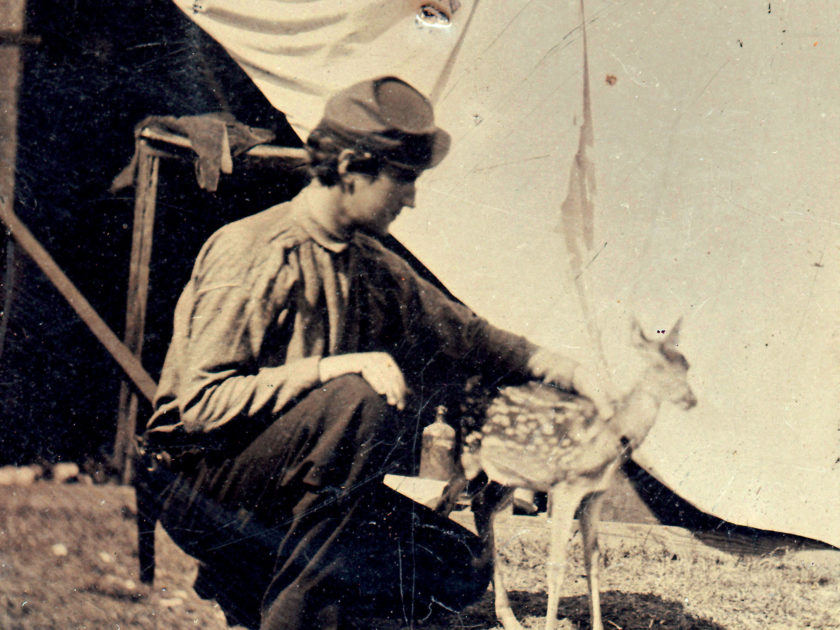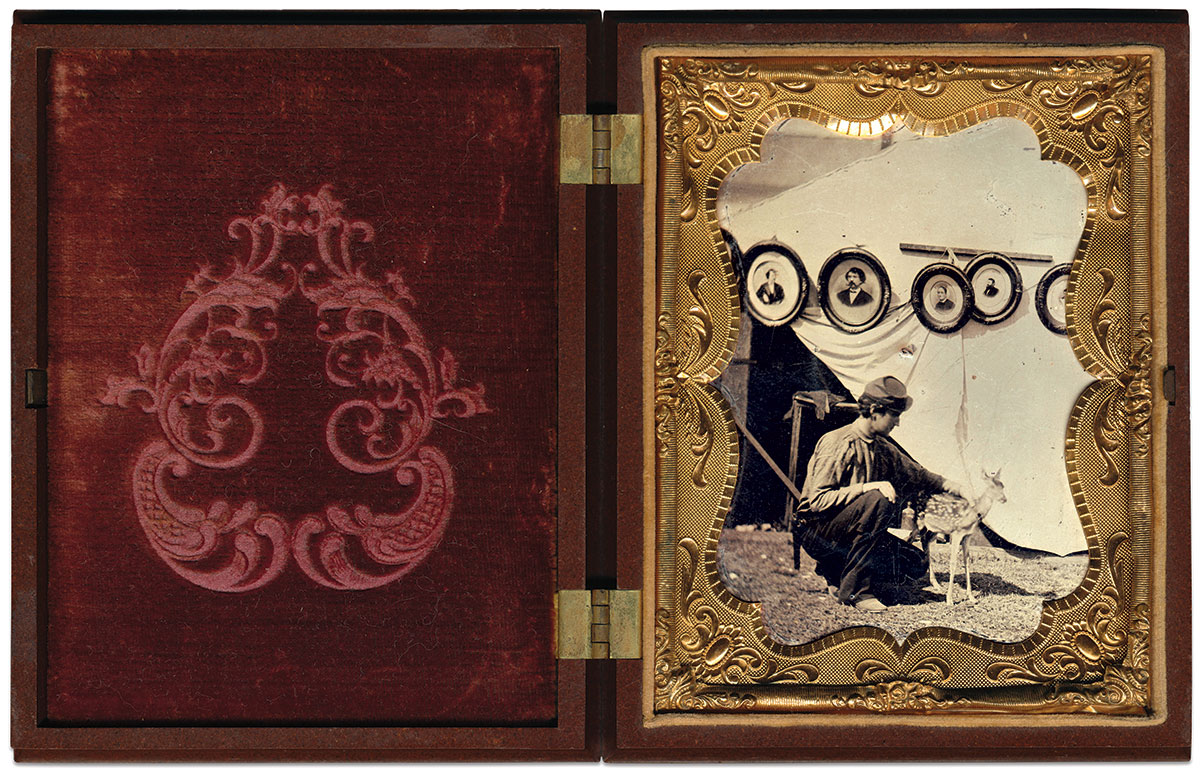
In the midst of death we are in life is a fitting way to describe this image of a young soldier resting a hand on a fawn. Was the soldier connected in some way to the photographer’s studio behind him?

These pards appear ready to defend each other against all comers. The fellow on the left wears his waist belt upside down, likely to compensate for the reversal effects of hard plate images of the time.

This Whitney revolver-yielding soldier sports a close cut and triple-breasted uniform—plus a prominent “Jeff Davis and the South!” placard. The sign is common to portraits taken in Corinth, Miss., early in the war.

A Federal enlisted man holds a quarter-plate image of another soldier, perhaps a comrade or family member lost in battle, for all to see. The presence of the hunting knife and revolver suggest he may be out to avenge his loss. The gun, a .32 caliber Moore’s Patent revolver—the first with a swing-out cylinder—was produced by inventor Daniel Moore in Brooklyn, N.Y. About 7,000 were made before Smith & Wesson sued for patent infringement in 1862. About half of the weapons were issued to New York troops, and the rest turned over to Smith & Wesson as part of the legal settlement. Possibly this man was a New Yorker.
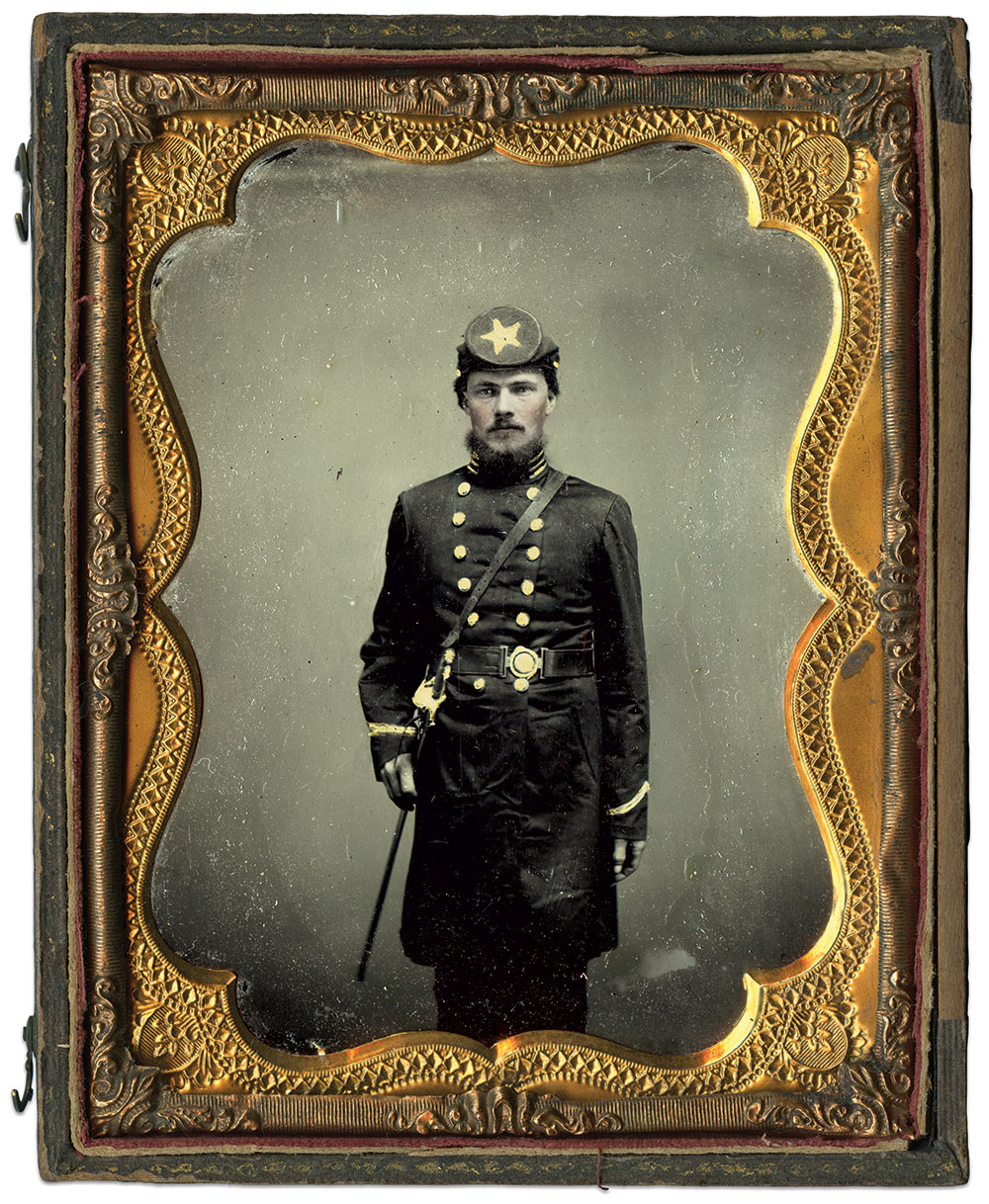
Nathan Bedford Forrest’s cousin, Albartus, posed for his portrait during his service as captain of Company F in the 31st Tennessee Infantry. Born and raised in McMinn County, he resigned his commission in April 1863, after about a year of service. Soon after his departure, the regiment reorganized as the 39th Mounted Infantry, and surrendered with the rest of the Confederate garrison at Vicksburg on July 4, 1863. Albartus went on to ride with his famous cousin. According to an ad placed in Confederate Veteran, in which Albartus sought to return a Bible captured from a Union soldier, he described himself as one of Forrest’s men: “I am one of them, and stuck to Forrest when the others left him at Plantersville, twenty-two miles North of Selma, Ala., near the close of the war.” He eventually returned to Tennessee, married, and moved to Texas, where he died in 1899 in his early 60s.
This image surfaced recently in Monterrey, Mexico, 125 miles across the U.S. border. Perhaps Albartus numbered among those Confederates who fled the country following the defeat of Southern arms, and left this portrait behind.
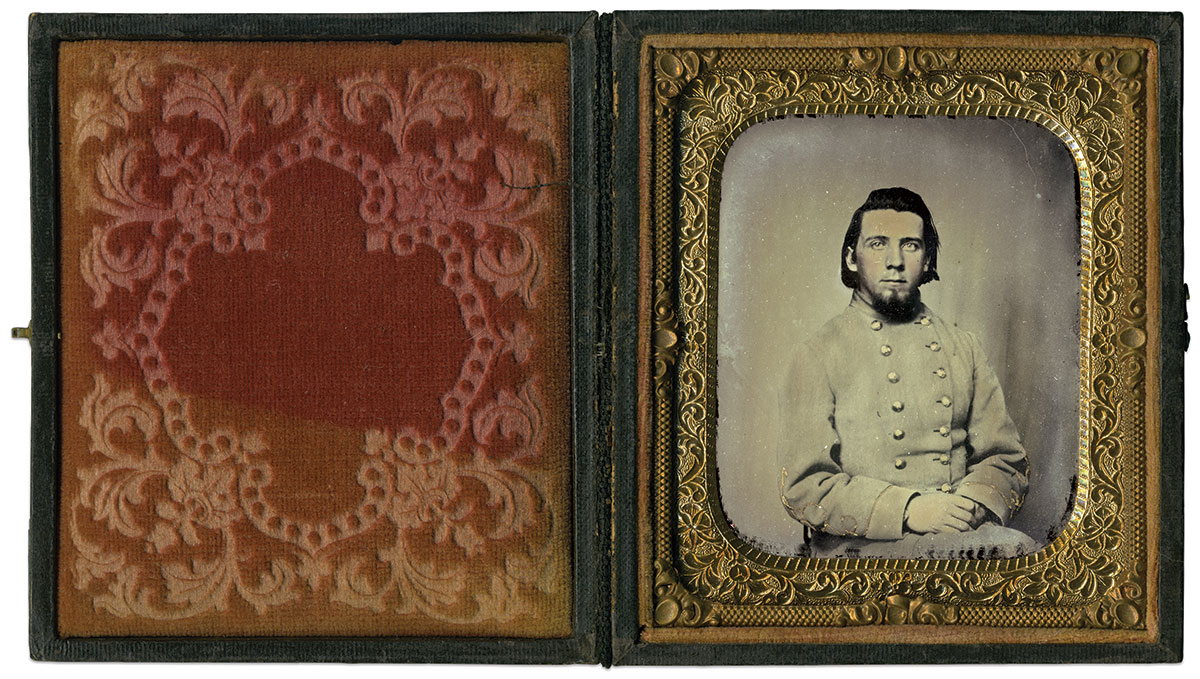
The sleeve braid worn by this officer indicates he ranked as a lieutenant. His beard obscures a collar insignia that could confirm his rank.

The finely detailed bowtie worn by this Confederate contrasts with the coarse weave of his coat.

At some point long after the war, an unnamed individual taped the images here to a piece of paper on which is typed the story of a mother’s sorrow and a young man’s demise. It begins, “This is a picture of one Civil War mother, and of the boy who did not come back.”
She was Lydia Barker Clark, shown below, the wife of Moses P. Clark of Patten, Maine, and mother of a daughter and six sons. Her eldest child, Alonzo, or Lon, “was just a slip of a boy with the fuzz of youth still on his chin” when he enlisted in Company E of the 31st Maine Infantry on March 11, 1864. The writer noted, “I seem to remember being told that as parting gifts, Lon gave little jackknives to two of his brothers. … Lon’s first trip away from home must have seemed very exciting to the young man, clouded only by the sadness of having to bid his family farewell. On the first lap of his journey, he was stationed in the barracks at Augusta, Maine, which I was told—on inquiry about twenty years ago—consisted of tents pitched along the long slanting hill from what is now the State House to the river’s edge in the valley. Imagine Maine in March, with all its snow and bitter cold of winter. There, almost at once, Black Measles broke out among the men, from which many of them died. Among the dead was Lydia’s son Lon. When word came, the mother was too ill to travel, so the boy’s father, Moses, took the trek to Augusta alone. Was it Moses who brought back the picture?”
Lon died on April 23, 1864. His military service lasted all of six weeks.

A bearded soldier, wearing a broad-brimmed hat and 4-button sack coat, is armed for conflict with a hunting knife and a U.S. Model 1842 smoothbore musket, which were mainly manufactured at the armories in Springfield, Mass., and Harper’s Ferry, Va.
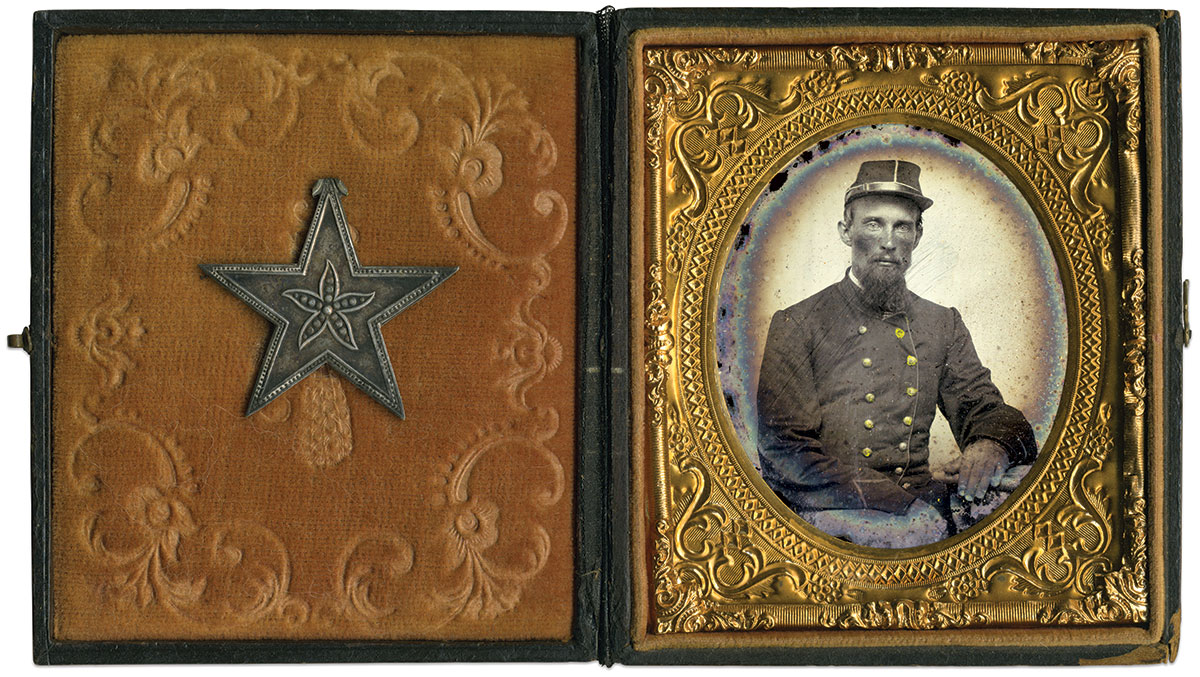
The identity of this rebel with fine trim on his cap and edge of his frock coat is not known. The star insignia attached to the velvet lining of the case however, may offer a clue to his name or origin.

A clean-shaven and intense Johnny Reb is plastered with belts and weapons. Included is a U.S. Pattern 1834 Artillery short sword with matching belt rig, a Model 1859 Sharps Carbine and a cartridge box sling. His belt plate appears to be embossed with the Georgia arches or Mississippi eagle.

A Southern infantryman in typical early war Georgia full dress poses with his musket and shako in front of a full size First National flag. The letters on his shako appear to be “GR,” which suggest he belonged to the Georgia Rangers of Pulaski County, which became Company G of the 10th Georgia, or Bibb County’s Gresham Rifles, which became Company A of the 45th Georgia.

A D-Guard Bowie knife and a flintlock rifle dominate this portrait of a soldier clad in a civilian placket-shirt. He is believed to be a Texan. Notice the revolvers tucked into his belt. The one on the left is a Colt, possibly a Dragoon model. The other is a rare federal-issue Joslyn revolver. According to Contributing Editor Phil Spaugy, it can be identified by the two screws in the grips and the distinctive cylinder pin removal knob at the rear of the revolver’s frame.
Spaugy adds, “The federal government purchased only 1,100 Joslyns in late 1861 and early 1862, with the first 250 revolvers going to the 5th Ohio Cavalry. Elements of the 5th skirmished against the 6th Texas in the spring of 1862 during the Shiloh/Corinth campaign. So that might explain how this Texan ended up with a fairly rare Yank revolver—either by capture, or perhaps some disgruntled Buckeye horse soldier tossed it aside.”
He continues, “It should be noted that the Joslyns were poorly made and were turned back to the Ordnance Department as soon as replacement arms could be had. Other U.S. cavalry regiments armed in part with this revolver were the 3rd and 7th Indiana, 16th Illinois, 7th Kansas, 1st Missouri, 10th Michigan, and the 5th and 6th Ohio.
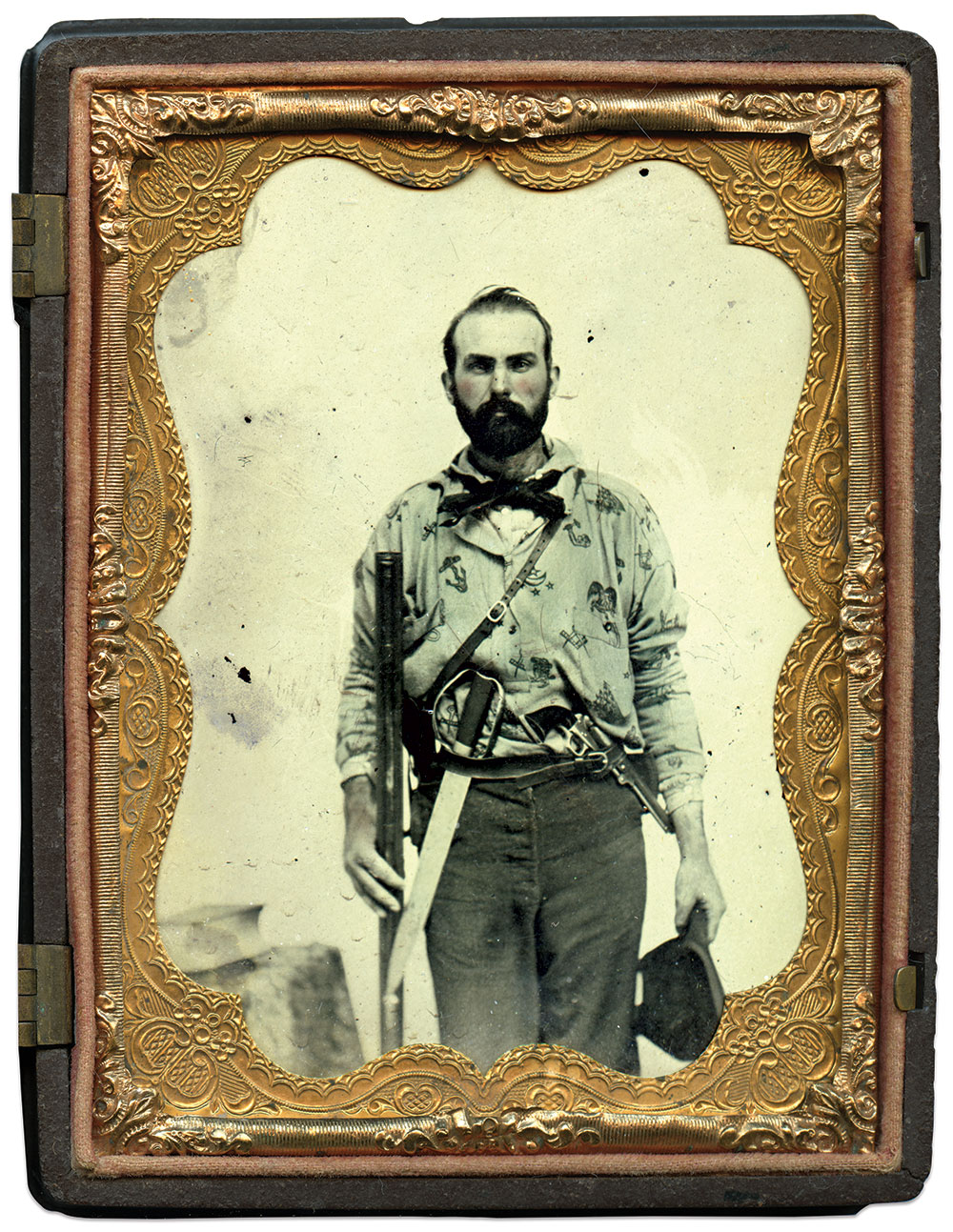
The blue-tinted shirt filled with nautical and masonic symbols dominates this portrait of a soldier. Though his name is currently lost to history, owner Kevin Canberg has a theory about the origins of the image, which recently surfaced in Houston, “In the Texas Portraits of Conflict volume there is an identified image where the soldier is very similarly outfitted with what looks to be the same double-barreled shotgun, revolver, and double D-guard Bowie knife, tucked in that same thin belt. They also have similar headgear and pants. Same three-quarter length poses, too. He may be part of the 9th Texas Cavalry.”
SPREAD THE WORD: We encourage you to share this story on social media and elsewhere to educate and raise awareness. If you wish to use any image on this page for another purpose, please request permission.
LEARN MORE about Military Images, America’s only magazine dedicated to showcasing, interpreting and preserving Civil War portrait photography.
VISIT OUR STORE to subscribe, renew a subscription, and more.

